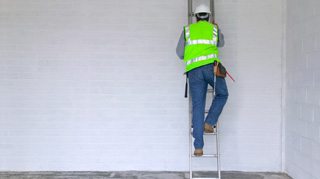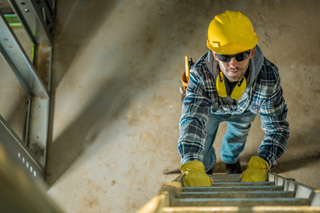- Home
- TrainingABC Blog
- Articles
- Safety
- The Importance of Ladder Safety in the Workplace
The Importance of Ladder Safety in the Workplace

Author Name: TrainingABC
Posted: 09-03-2021 05:06 AM
Views: 9468
Synopsis: The safe use of ladders in the workplace is a critical part of workplace safety training.
Ladders are an integral part of operations in nearly every workplace. They allow workers quick and efficient access to out of reach heights. However, ladders can also be dangerous if they are not operated properly and kept in good working condition. All workers who use ladders, whether occasionally or every day should be trained on their safe use. It may just prevent a serious injury or fatality.
The Structure of a Safe Ladder
OSHA has specific guidelines for the structure of a safe ladder and ladders that do not meet these standards must be taken out use.
 Ladders must meet the following criteria:
Ladders must meet the following criteria:
- Ladder steps, rungs, or cleats should be uniformly spaced, parallel, and level when in position for use.
- Portable or extension ladders should have secure, non-slip, safety feet to keep them in place.
- Ladders must have rungs or steps that are coated with slip resistant material or are corrugated, dimpled, or knurled to reduce slippage.
- Step ladders or combination ladders used in step ladder mode must have secure locking devices that hold the ladder in the open position.
- Single rail ladders are dangerous and must never be used.
- Ladders taller than 24 feet require ladder safety systems or personal fall arrest systems. Ladders installed before November 19, 2018, may still use safety cages, and do not fall under this requirement but must be in compliance by 2036.
OSHA has specific sizing, dimensional, and material guidelines for the space between steps, the space between rungs and walls, the size of rails, and the many other parts and dimensions of ladders. These requirements are different for step ladders, portable ladders, fixed ladders, and all other ladder types. Employers must ensure that all ladders in their workplace meet these specific requirements.
Ladder Surfaces
 Wooden ladders may not be coated with any substance that could hide a structural defect. Metal ladders must be constructed with corrosion resistant materials or designed with corrosion protection. Ladder surfaces must be free of edges, points, and defects that could cause punctures or lacerations during use.
Wooden ladders may not be coated with any substance that could hide a structural defect. Metal ladders must be constructed with corrosion resistant materials or designed with corrosion protection. Ladder surfaces must be free of edges, points, and defects that could cause punctures or lacerations during use.
Inspection
Ladders must be inspected for conditions and defects that could cause injury before every work shift (and before every use when possible).
- Ladder surfaces must be checked for cracks and defects.
- Bolts and rivets must be secure.
- Ladder safety feet must not be loose and must lock in place properly. Check the tread on the bottom of the feet to ensure they are not overly worn.
- Ladders should stand straight and not sway or lean to the side.
- Steps, rungs and supports should be sturdy and in proper working condition.
- Extension ladder ropes should not be frayed, slides should move smoothly and locking mechanisms should lock correctly.
- Ladder surfaces must be free of oil, grease, or other substances that could cause a slipping hazard.
Ladders deemed to have structural or other defects must be tagged “Dangerous: Do Not Use” and moved from service.
Safe Use
 Before getting on a ladder workers should take precautions to ensure their safety. Workers must be physically capable of operating a ladder safely.
Before getting on a ladder workers should take precautions to ensure their safety. Workers must be physically capable of operating a ladder safely.
- No worker should ever use a ladder when intoxicated or under the influence of prescription drugs that cause dizziness.
- Ladders should never be used by workers who are sick, injured, or physically unable for any reason.
- Workers with a fear of heights should never be allowed or forced to use a ladder.
Safe conditions must be present for ladder use.
- Never use a ladder outside in windy or rainy conditions.
- Metal ladders must not be used around electrical wiring, electrical machines, or power lines.
- Ensure that ladders are never placed on a box, barrel, or other unstable surface to gain additional height.
- When ladders are placed in busy locations such as driveways passageways, or doorways they must be secured to prevent accidental displacement or guarded with a temporary barricade such as fencing, traffic cones or caution tape.
- If a ladder is placed in front of a door, make sure the door is locked or barricaded to avoid someone coming through and causing an accident.
- Check the ladder’s weight capacity to ensure it can support the weight you will be putting on it. Weight capacities include the weight of the user and all tools and loads brought on it.
 Ladders must be secured and in proper position for safe use.
Ladders must be secured and in proper position for safe use.
- Ensure that the tops of both rails are supported unless the ladder is equipped with a support device.
- Ladders must be placed on stable or level surfaces unless they are secured or stabilized to prevent accidental displacement.
- When using ladders on a soft surface a wide board should be used to stabilize the base.
- Ladders should be secured and stabilized when placed on slippery surfaces.
- Portable or extension ladders should be placed with a 4 to 1 ratio - for every 4 feet of ladder there should be 1 foot of clearance from the wall.
- When ladders are used to gain access to an upper landing or roof, the top of the ladder must extend three feet past the landing’s surface.
- Ensure that step ladders are fully opened and in the locked position before use. Using a partially closed or closed step ladder is dangerous and could cause serious injury or death.
- Never use a ladder for a purpose that it was not intended.
- When working with tools while on a ladder, barricade the area below to avoid accidentally dropping an object on a bystander.
- Ladders or ladder sections should never be tied together or stacked upon each other unless they were specifically designed for this purpose.
- When using a portable ladder alone secure the top of the ladder with a rope, cord, or other means and anchor the base to a nearby heavy object or building to help prevent accidents.
 Adhere to the following guidelines when using ladders.
Adhere to the following guidelines when using ladders.
- Face ladders when climbing up or down.
- Always have three points of contact when climbing up and down ladders – this means either two hands and one foot or two feet and one hand always touching the ladder.
- Never skip a step when ascending or descending a ladder.
- Whenever possible one worker should climb the ladder while the other keeps the bottom of the ladder stable.
- Always wear properly fitted shoes that have a slide resistant tread and that are free of mud, oil, or other slippery substances.
- Always have at least one hand on the ladder while working.
- Never lean backwards and keep your weight parallel with the rails.
- Never carry anything that could cause a loss of balance and result in a fall.
- Never reach for an object that shifts your weight away from the center of the ladder. Over-reaching is one of the most common cause of ladder falls.
- Use a toolbelt to carry loads up and down ladders or hoist loads after ascending.
- Never move, shift, or extend a ladder while an employee is on it.
- Never share a ladder with another employee unless the ladder was designed for multiple users.
- Never use the top cap or top rung of a step ladder as a step. In general, it is not safe to use the last two steps of a step ladder or the last four of steps of an extension ladder.
- Never sit on the rung of a ladder or the top of a step ladder.
- Never step on the back side of an extension ladder or the supports of a step ladder.
- Never leave a portable or step ladder unattended. Ladders should always be stored when not in use.
Moving a Ladder
The safest way to move a ladder is to take it down and carry it horizontally. However, if a ladder must be moved in the vertical position do so slowly and carefully. For heavy or long ladders (like extension ladders) use two workers and move carefully as its common for accidents to occur in the process.
Falls and Injuries
Even when following all safety standards, falls still happen. Workers who fall should make every attempt to relax their body and roll with the fall to absorb as much shock as possible. Fall injuries can be serious and involve head or spinal damage. Avoid moving a fall victim unless they are in a dangerous location and immediately call 911.
Conclusion
Every year there are over one hundred and fifty thousand emergency room visits and 300 deaths from ladder falls. Amazingly most of the deaths are from falls of 10 feet or less. By carefully following safety protocols when using ladders, injuries and deaths can be significantly reduced. It may save your life or the life of someone in your organization.
Check out TrainingABC's new video-based course on ladder safety.
